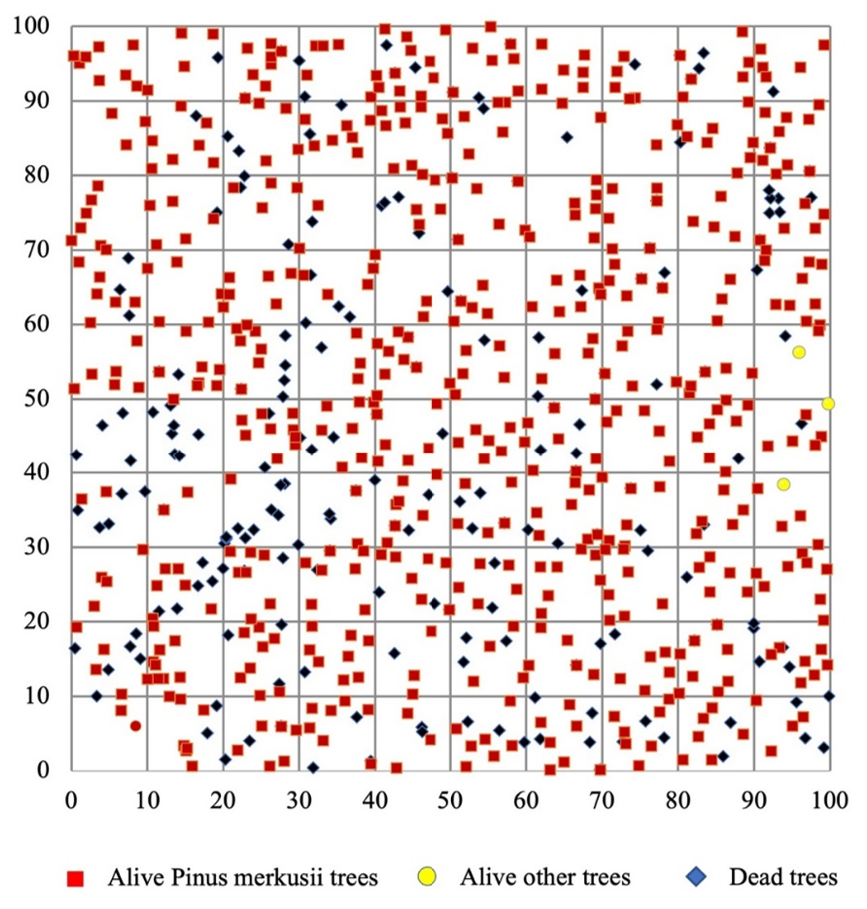Impact of land slope, tree density and basal area on fire intensity in pinus merkusii plantation forest

Forest fires are not solely determined by the quantity and quality of plant debris as fuel, but also influenced by some extrinsic factors. This study aims to examine the effect of some factors (slopes, tree density, and tree basal area) on the intensity of forest fires. The study was conducted in a 1 ha (100m x 100m) plot in the Pinus merkusii plantation 10 months after the fire. The plot was divided into 10 m x 10 m subplots, therefore there were 100 subplots. Each tree over 5 cm in diameter found in the plot was numbered consecutively, recorded its species name, measured its diameter, and determined whether it was alive or dead. The slope level in each subplot was measured. Multiple regression analysis was used to detect the influence of slope level, tree density, and basal area on the number of dead trees in each subplot. Results show that slopes, tree density, and basal area influenced proportionally the intensity of forest fires (R2 = 0,507; p<0.05). However, when the partial analysis was applied to detect the influence of each class factor, not all of the classes were found significant. These results reveal that there are several other factors not measured in this study that also influence fire intensity, which we suspect are tapping holes and tree diameter.
Akbar, A. (2007). Peranan penyiangan frekuensi manual terhadap penurunan resiko kebakaran pada hutan tanaman. Jurnal Penelitian Hutan Tanaman, 4(1), 51–67. https://doi.org/10.20886/jpht.2007.4.1.51-67.
Brumelis, G., Dauškane, I., Elferts, D., Strode, L., Krama, T., & Krams, I. (2020). Estimates of tree canopy closure and basal area as proxies for tree crown volume at a stand scale. Forests, 11(11), 1180. https://doi.org/10.3390/f11111180.
Estes, B.L., Knapp, E.E., Skinner, C.N., Miller, J.D., & Preisler, H.K. (2017). Factors influencing fire severity under moderate burning conditions in the Klamath Mountains, northern California, USA. Ecosphere, 8(5), e01784. https://doi.org/10.1002/ecs2.1794.
Ghodrat, M., Edalati-Nejad, A., & Simeoni, A. (2022). Collective effects of fire intensity and sloped terrain on wind-driven surface fire and its impact on a cubic structure. Fire, 5(6), 208. https://doi.org/10.3390/fire5060208.
IFFM. (2003). Mencari strategi kampanye pencegahan kebakaran hutan. prosiding workshop pencegahan kebakaran hutan, Proyek Uni- Eropah (SCKPFP). Banjarbaru.
Kreye, J.K., Koziar, L.N., & Zipperer, W.C. (2012. Effects of fuel load and moisture content on fires behavior and heating in masticated litter dominated fuel. International Journal of Wildland Fire, 22(4), 440-445. https://doi.org/10.1071/WF12147.
Lecina-Diaz, J., Alvarez, A., & Retana, J. (2014). Extreme fire severity patterns in topographic, convective and wind-driven historical wildfires of Mediterranean pine forests. PLoS One, 9(1), e85127. https://doi.org/10.1371/journal.pone.0085127.
Linder, P., Jonsson, P., & Niklasson, M. (1998). Tree mortality after prescribed burning in an old-growth Scots pine forest in northern Sweden. Silva Fennica, 32(4), 339–349. https://doi.org/10.14214/sf.675.
Moreau, E., Bédard, S., Moreau, G., & Pothier, D. (2018). Relationships between tree vigor indices and a tree classification system based upon apparent stem defects in northern hardwood stands. Forests, 9(10), 588. https://doi.org/10.3390/f9100588.
Njeri, W.F., Githaiga, J.M., & Mwala, A.K. (2018). The effects of fires on plants and wildlife species diversity and soil physical and chemical properties at Aberdare Ranges, Kenya. Asian Journal of Forestry, 2(1), 25-38. https://doi.org/10.13057/asianjfor/r020104.
R Core Team. (2021). R: A language and environment for statistical computing. R Foundation for Statistical Computing, Vienna, Austria. URL https://www.R-project.org/.
Rodrigues-Corrêa, K.C.D.S., de Lima, J.C., & Fett-Neto, A.G. (2013). Pine oleoresin: tapping green chemicals, biofuels, food protection, and carbon sequestration from multipurpose trees. Food and Energi Security, 1(2), 81-93. https://doi.org/10.1002/fes3.13.
Rubini, M., Clopeau, A., Sandak, J., Dumarcay, S., Sandak, A., Garardin, P., & Charrier, B. (2022). Characterization and classification of Pinus oleoresin samples according to Pinus species, tapping method, and geographical origin based on chemical composition and chemometrics. Biocatalysis and Agricultural Biotechnology, 42, 102340. https://doi.org/10.1016/j.bcab.2022.102340.
Song, H.S., & Lee, S.H. (2016). Effects of wind and tree density on forest fire patterns in a mixed-tree species forest. Forest Science and Technology, 13(1), 9-16. https://doi.org/10.1080/21580103.2016.1262793.
Stephens, S.L., Mclver, J.D., Boener, R.E.J., Feting, C.J., Fontaine, J.B., Hartsough, B.R., Kennedy, P.L., & Schwilk, D.W. (2012). The effects of forest fuel-reduction treatments in the United States. BioScience, 62(6), 549-560. https://doi.org/10.1525/bio.2012.62.6.6.
Stephens, S.L., Bernal, A.A., Collins, B.M., Finney, M.A., Lautenberger, C., & Saah, D. (2022). Mass fire behavior created by extensive tree mortality and high tree density not predicted by operational fire behavior models in the southern Sierra Nevada. Forest Ecology and Management, 518, 120258. https://doi.org/10.1016/j.foreco.2022.120258.
Syaufina, L. & Sukmana, A. (2008). Tinjauan penyebab utama kebakaran hutan di daerah tangkapan air danau Toba. TTO PROJECT PD, 394(06).
Zaluma, A., Strike, Z., Rieksts-Riekstiņš, R., Gaitnieks, T., & Vasaitis, R. (2022). Long-term pathological consequences of resin tapping wounds on stems of Scots pine (Pinus sylvestris L.). Trees, 36, 1507–1514. https://doi.org/10.1007/s00468-022-02307-y.

